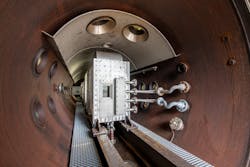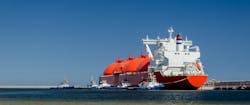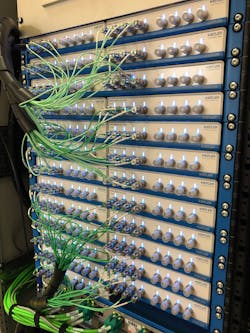Measuring sloshing wave impacts under extreme conditions
The Maritime Research Institute Netherlands (MARIN) in Wageningen is one of the world's leading marine research centers. Since 1932, MARIN has built up a vast stock of expertise based on a combination of numerical simulations and experiments performed in large-scale facilities comprising various basins for ship model tests, together with on-board measurement and testing.
Accurate pressure measurement in demanding environments
- Short rise time, high sensitivity and natural frequency
- Optimized membrane to reduce thermal shock
- Very wide operating temperature range (‒196°C to +350°C)
- Pressure range up to 250 bar (3,626 psi)
- Variants with charge (PE) or voltage (IEPE) output available
These extremely compact sensors – with a diameter of only 5 mm – can be mounted with different housings, adapters and cables to best fit the application scenario.
Precise results under varying environmental conditions
Rodrigo Ezeta, a researcher at MARIN who holds a Ph.D. in fluid mechanics, explains the approach: “The Atmosphere offers full environmental control of temperature and pressure: this is relevant for LNG carriers, which normally operate close to the boundary between liquid and vapor. This gives us a better understanding of the sloshing phenomena that occur in a real container inside a ship.”
Inside the autoclave lies a flume where waves can be created artificially. As soon as these waves hit the impact wall, pressure sensors from Kistler record the impact loads with a very high degree of accuracy, and 100 of these sensors are installed in a T-shaped array.
“During the commissioning phase of the facility, we found that this is the best layout to obtain precise impact loads, Ezeta said. “The upper part of the T-shaped array allows detailed capture of the loads generated by the wave crest, while the lower part of the T registers the effects of the gas pocket that can be ‘trapped’ in between the wave and the wall.”
According to Ezeta, research has already shown that these gas pockets – in addition to the loads generated by the wave crests – can have a non-negligible effect, so they could also exert a detrimental influence on the container.
Synchronized signals from a hundred sensors
Due to their high natural frequency and short rise time, the pressure sensors from Kistler can capture the highly dynamic sloshing events inside the flume. They also feature an optimized membrane to minimize the thermal shock that occurs when sensor exposure changes suddenly from gas to liquid. To prevent noise and bias effects, the Kistler engineers developed a special cable solution that transmits the signals from the test chamber through a vacuum tube to the outside of the autoclave. Signal processing and data acquisition are then handled by 25 automatically synchronized LabAmp 5165A charge amplifiers, which directly digitize the signals of all 100 pressure sensors at a rate of 100 kHz. “We’re very happy with the solution from Kistler. It’s reliable and robust, and it works almost flawlessly,” Ezeta said.
Precisely synchronized fast-sampled charge signals
The LabAmp 5165A from Kistler is a dynamic dual-mode laboratory charge amplifier and data acquisition device for piezoelectric sensors. Key features include:
A high sampling rate combined with scalability and excellent signal quality make the 5165A the perfect choice for this challenging 100-channel application.
What are the main goals of research at MARIN’s The Atmosphere, and what results can be expected?
“The installation only became fully operational in early 2020, so we’re still at the beginning of our research. One major goal is to improve the scaling models that the industry has used until now,” Ezeta explains.
At present, sloshing tests are typically conducted with a small tank on a moving hexapod so as to simulate sloshing. But when the sloshing dynamics are upscaled to real-size dimensions, biases arise in the tests due to the complexity of the underlying physical mechanisms at play.
Ezeta continues: “One of our main objectives is to reduce the uncertainty caused by this scaling. And a good way of doing that is to start by trying to understand the physics behind these impacting events. To achieve this, we perform tests with waves under varying temperature, pressure and gas conditions so we can see the effects on the impact loads that are measured by the Kistler sensors. One key question is: why do the pressures vary so much?”
The answer to this question is a topic of active research, because it is influenced by other important aspects such as the appearance of small perturbations along the wave crests, the oscillation of entrapped gas pockets and the magnitude of the gas-to-liquid density ratio, which changes with temperature, pressure and different gas mixtures. This turns out to be a key factor for sloshing events, so it also plays an important part in the design of tanks within ships.
Results also expected to benefit hydrogen tanker design
“Research so far has already shown that it is important to take all physical parameters and effects into account,” Ezeta said. “Our results will give businesses a better understanding of what is happening inside their tanks, and this will help them to keep on improving their testing methodologies. And, last but not least, our research is an enabler for a new type of tanker that will carry hydrogen rather than natural gas.”
In theory, hydrogen is even more sustainable than natural gas because its combustion does not produce any greenhouse gases; however, it has a very low liquefaction temperature of 33 Kelvin (corresponding to ‒253°C under atmospheric conditions). The world’s first liquefied hydrogen tankers are expected to become operational in 2021.
Rodrigo Ezeta sums up his experience with the measurement technology: “We’re very satisfied with our collaboration with Kistler, and we're looking forward to many successful tests thanks to sensors that are renowned for their long-term durability and stability. We are also constantly looking for new collaborations within academia and different industries, where the ATM with it unique features can provide accurate measurements. Our Atmosphere is open to everyone!”
For more information, go to kistler.com.




